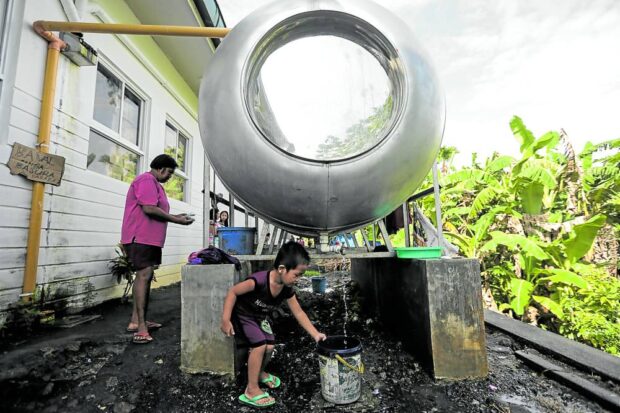Mayon evacuees grapple with water shortage in shelters

SAFE SOURCE | Evacuees use clean water for cleaning and bathing provided by the response team and the local government to ensure their well-being and hygiene while staying at a temporary shelter in Barangay San Andres, Sto.Domingo town, Albay, as shown in this photo taken on July 1, 2023. (Photo by MARK ALVIC ESPLANA / Philippine Daily Inquirer)
LEGAZPI CITY, Albay, Philippines — Despite the hassle, Jhenny Rose dela Cruz, 34, and her family still have to go back and forth to their home in Sto. Domingo town in Albay province to take baths and do laundry, as the water supply in evacuation centers was not enough to meet the needs of thousands of families who left their villages at the foot of the restive Mayon Volcano.
“The Bureau of Fire Protection (BFP) supplies water, but because there are many users and most of them are taking a bath there, the water supply gets depleted the next day,” Dela Cruz, a housewife, said in a phone interview on Tuesday.
She said her family of eight (Dela Cruz, her husband, their three children, and three other relatives) evacuated to a public school in Barangay San Andres but later transferred to the nipa hut they built close by. Although they would sometimes sleep at their house in Barangay Fidel Surtida to let her three kids sleep comfortably, she admitted.
The province ordered the mandatory evacuation of residents living within Mayon’s 6-kilometer permanent danger zone (PDZ) on June 9, a day after the Philippine Institute of Volcanology and Seismology (Phivolcs) raised the alert level 3 status (increased tendency toward a hazardous eruption) over the volcano.
Noreta Baredo, 41, also a housewife, had to wash her sickly grandmother’s clothes and bedding every day at their house in Purok 1, Barangay Lidong of Sto. Domingo because of the limited supply of water at the evacuation center in Sitio Bical of Barangay Salvacion in the town.
Article continues after this advertisement“I need to do laundry at home because the water supply is very limited (at the evacuation center). I do it daily because my bedridden grandmother is peeing in bed, especially now that I don’t have a budget for diapers,” Baredo said in a separate phone interview.
Article continues after this advertisementBaredo’s grandmother and six children evacuated at Sto. Domingo Central School on June 12 but later transferred to a nipa hut in Sitio Bical.
Delivery
She said she would rather spend at least P100 daily for the gasoline of her service motorcycle in going to and from her house instead of dealing with a limited water supply that was not even enough to clean the toilets at their temporary shelter. Potable water stored in jerry cans and water tanks is regularly delivered to the villages and evacuation centers where water supply is a problem, according to Sto. Domingo Mayor Joseling Aguas Jr.
“Water supply is really a problem at Sitio Bical and even in (other villages). We cannot drill (for) water, so we fetch water for them,” Aguas said in a chat message Tuesday.
William Sabater, coordinator of Water Sanitation and Hygiene (Wash) Albay, said the evacuees should also conserve the water regularly delivered to them.
Apart from the regular 12,000 liters of water per delivery (every other day) provided for the evacuation centers, the Philippine Red Cross and the BFP also augmented the supply in every evacuation center.
“While doing laundry, some just let the water freely flow; they should also consider other users. Even if we supply enough water, if they don’t know how to conserve, it would be immediately depleted,” Sabater said in a phone interview on Tuesday.
Chlorinated
He said that, based on their weekly monitoring of potable water sources, some samples tested positive for E. coli, but they immediately addressed it by distributing chlorine tablets and powder to the evacuees.
But Sabater said the evacuees were not used to drinking chlorinated water, prompting them to tap a refilling station to supply water to all temporary shelters in the province since Sunday.
He said the province initially utilized water filtration machines in different evacuation centers to assure a safe and potable water supply.
“They use water filtration units, but since it is also chlorinated, the evacuees still go back to their residence to get [water] there,” Sabater added.
At least 5,781 families, or 20,157 people, were evacuated from the PDZ and the 7-km to 8-km extended danger zone in the towns of Daraga, Camalig, Guinobatan, Malilipot, and Sto. Domingo; and the cities of Legazpi and Tabaco.
In the latest bulletin, Phivolcs reminded the public to avoid the danger zones as lava flow from the summit crater has advanced to 2.8 km along Mi-isi gully in Daraga town, 2.4 km in Bonga gully in Legazpi City, and 600 meters along Basud gully in Sto. Domingo.
Phivolcs has also recorded three pyroclastic density currents, 150 rockfall events, and 267 volcanic earthquakes, while the collapse debris has deposited 4 km along the Basud channel in Sto. Domingo as of Monday.